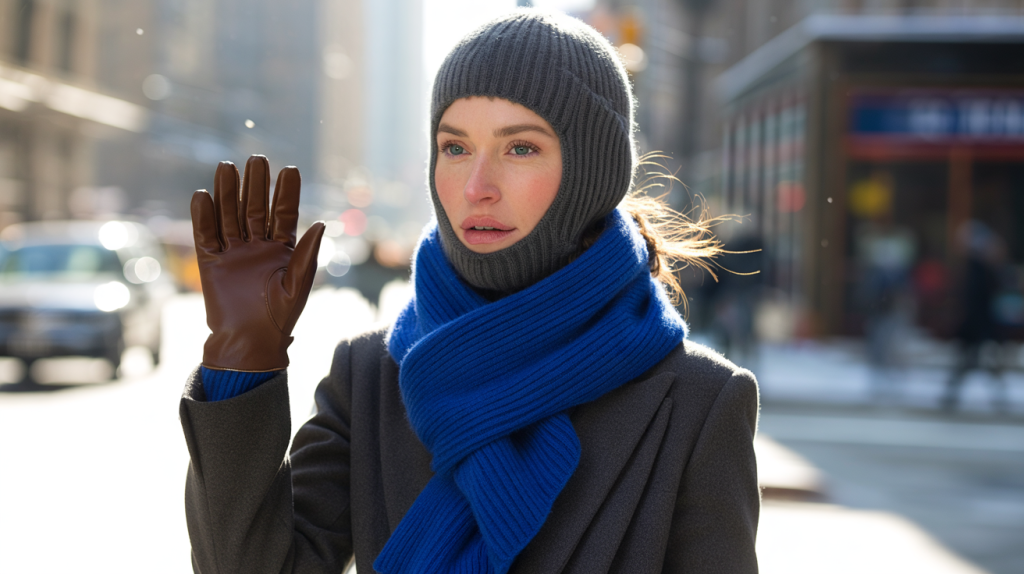Smart warmth meets style: discover how a scarf, gloves and a balaclava tailored for women solve real cold-weather problems without sacrificing looks.
Cold bites fast. NOAA’s wind chill chart (2024) shows frostbite can start in 30 minutes when the wind chill hits -28 °C, which many cities touch during Arctic blasts. No surprise the search for a snug scarf, reliable gloves and a balaclava that actually fits is peaking. This trio shields neck, hands and face – the exact zones that leak heat first on a platform, on a bike or on the school run.
Here is the point: the classic women’s set – écharpe, gants, cagoule – balances warmth, breathability and polish better than a bulky hood alone. One layer traps heat, another blocks wind, the last preserves comfort when moving and talking. The result feels simple, looks clean and works in real life, whether that life includes a commute or a mountain sidestep.
Why the “écharpe gants cagoule femme” set is trending now
Recent winters turned unpredictable. One week damp and mild, the next week a deep freeze. People needed adaptable protection they can layer or stash in a tote. A scarf warms the chest, gloves keep dexterity for a phone, and a balaclava seals gaps around cheeks and ears without flattening hair.
Health data backs the focus on coverage. A multi-country study in The Lancet (Gasparrini et al., 2015) linked non-optimal temperatures to 7.71% of deaths, with cold responsible for the large share. Covering extremities reduces exposure time and cuts risk during daily chores more than one bulky coat ever will.
Sustainability now shapes what we pick. Textile Exchange reported in 2023 that polyester made up about 54% of global fiber production in 2022. That scale pushed brands to blend recycled synthetics with natural fibers for warm yet lighter knits. The set format makes smart blends easier – wool where heat counts, recycled fleece where softness matters.
Materials and fits : scarf, gloves, balaclava explained
Start with the scarf. Merino wool or cashmere manages moisture and stays warm when damp. Recycled polyester fleece traps air, dries quickly and weighs little. Long, narrow scarves wrap twice without bulk, while square scarves cover the upper chest – great under a blazer or parka.
Gloves are about grip and movement. Look for touchscreen-friendly index and thumb pads to avoid bare-skin scrolling. A knit liner under a leather shell boosts warmth without losing steering-wheel feel. Wrist-length cuffs tuck inside sleeves to block drafts; gauntlet cuffs sit over them for bike rides.
The balaclava is the clincher. A thin merino knit under a helmet, or a double-knit cotton blend for city wear, shapes softly around the jaw and nose. A convertible design – open face, half-mask or full cover – adapts to a windy bridge then flips down for coffee. One detail many skip: flat seams that do not rub along the cheekbones.
Common slip-ups keep showing up in fitting rooms: picking only chunky yarns that overheat on a bus, choosing gloves with long fingers that reduce dexterity, or balaclavas too tight at the crown that ride up. Fit beats thickness almost every time.
Quick checklist to nail the trio in minutes :
- Scarf length that wraps twice without pulling – about the same as your height works well.
- Gloves with snug palms and short fingertips so typing and zippers stay easy.
- Balaclava with a convertible opening and flat seams for glasses comfort.
- Breathable natural fiber near skin, wind-stopping layer outside for real cold.
- Color plan: one neutral, one accent – the set looks intentional, not random.
Style plays for women : from city commute to slopes
Anecdote from the sidewalk: what looks warm also sets the tone of the outfit. A ribbed camel scarf with chocolate leather gloves and a cream balaclava feels polished for office hours. Switch to a cobalt scarf, knit gloves and a charcoal balaclava and the bike ride reads sporty, not scruffy.
Texture mixing keeps the trio interesting. Pair a fuzzy scarf with smooth leather gloves, or a sleek merino balaclava with a chunky fisherman scarf. Small hardware – a cuff snap, a subtle logo patch – adds a tiny glint without shouting. One accent color is plenty; two fight each other on a grey morning.
Travel plan? The balaclava packs flat and doubles as a beanie when folded. Gloves clip together in the bag so one does not vanish. A lighter mid-length scarf works on planes, then layers under a puffer at arrival. Sounds obvious, yet it saves space and sanity.
Care, returns et smart buying moves that pay off
Practical note from retail: apparel returns pile up fast. The National Retail Federation reported an average online return rate of 17.6% in 2023. Measuring palm width and head circumference before ordering cuts that back – less guesswork, fewer boxes.
Care matters for longevity. Wool likes gentle, cool washes and flat drying. Leather gloves enjoy a light conditioner at season’s end. Recycled fleece sheds less when washed in a bag and dried on low. Tiny habits extend life, which keeps both costs and clutter down.
One last angle ties comfort to safety. NOAA’s wind chill guidance (2024) shows how breeze multiplies exposure – a simple neck seal and cheek cover add minutes of protected time when the forecast swings. That margin is the difference between rushing and moving calm, even on a sharp morning.
The missing piece for many wardrobes is not a heavier coat. It is coordination. A women’s écharpe, gants, cagoule set built with breathable fibers, tight seams and clean lines adapts from drizzly Tuesdays to crisp Saturdays. Get the fit, then the color. The rest will accomodate your winter without fuss.
